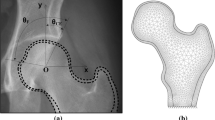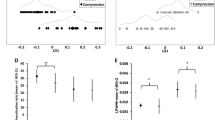Abstract
Structural arrangements of the bony microstructure of a joint through adaptational processes are thought to be determined by the biomechanical demands and its changes. Pursuing this theory of “form follows the biomechanical function”, the load distribution of the glenoid cavity, as it is mirrored in its mineralization pattern, should link not only to its thickness distribution, but also will have an impact onto the trabecular network below. To prove and confirm this hypothesis, we analysed the mineral distribution in correlation to the subchondral bone plates thickness and the distribution of architectural parameters of the trabecular network below. Our findings clearly state an inhomogeneous but regular and reproducible mineral distribution pattern in respect to the biomechanical demands and a thickness of the subchondral bone plate which shows a significant correlation (78–93%). As for the trabecular network below, the distribution of the analysed parameters also revealed an inhomogeneous distribution with a regular pattern in correlation to the biomechanical impact. We found distinctive maxima of material distribution and stability (bone volume 79%, plate-like architecture 77%) situated below areas of high long-term load intake. With increasing depth, the trabecular network administers the expression of each structural parameter following the fact that the strain energy gets more and more evenly distributed and changes from a high degree of differentiation just beneath the SBP to a more equal distribution within the deeper areas. After all, the biomechanical situation of a joint directly influences the bony formation of the subchondral bone plate and the trabecular network below.




Similar content being viewed by others
References
Birkenhäger-Frenkel D, Courpron P, Hüpscher E, Clermonts E, Coutinho M, Schmitz P, Meunier P (1988) Age-related changes in cancellous bone structure. A two-dimensional study in the transiliac and iliac crest biopsy sites. Bone Miner 4:197–216
Bouchaib J, Clavert P, Kempf J-F, Kahn J-L (2014) Morphological analysis of the glenoid version in the axial plane according to age. Surg Radiol Anat 36:579–585
Carter DR (1984) Mechanical loading histories and cortical bone remodeling. Calcif Tissue Int 36:S19–S24
Carter DR, Beaupré GS (2007) Skeletal function and form: mechanobiology of skeletal development, aging, and regeneration. Cambridge University Press, Cambridge
Cheal E, Snyder B, Nunamaker D, Hayes W (1987) Trabecular bone remodeling around smooth and porous implants in an equine patellar model. J Biomech 20:1121–1134
Cowin SC (2001) Bone mechanics handbook. CRC Press, London
Day J, Ding M, Odgaard A, Sumner D, Hvid I, Weinans H (2000) Parallel plate model for trabecular bone exhibits volume fraction-dependent bias. Bone 27:715–720
Dempster DW, Compston JE, Drezner MK, Glorieux FH, Kanis JA, Malluche H, Meunier PJ, Ott SM, Recker RR, Parfitt AM (2013) Standardized nomenclature, symbols, and units for bone histomorphometry: a 2012 update of the report of the ASBMR Histomorphometry Nomenclature Committee. J Bone Miner Res 28:2–17
Eckstein F, Muller-Gerbl M, Putz R (1992) Distribution of subchondral bone density and cartilage thickness in the human patella. J Anat 180(Pt 3):425–433
Engelke K, Karolczak M, Lutz A, Seibert U, Schaller S, Kalender W (1999) Micro-CT. Technology and application for assessing bone structure. Der Radiol 39:203–212
Feldkamp LA, Goldstein SA, Parfitt MA, Jesion G, Kleerekoper M (1989) The direct examination of three-dimensional bone architecture in vitro by computed tomography. J Bone Miner Res 4:3–11
Frich LH, Odgaard A, Dalstra M (1998) Glenoid bone architecture. J Shoulder Elbow Surg 7:356–361
Hildebrand T, Ruegsegger P (1997) Quantification of bone microarchitecture with the structure model index. Comput Methods Programs Biomed 1:15–23
Hoechel S, Schulz G, Müller-Gerbl M (2015) Insight into the 3D-trabecular architecture of the human patella. Ann Anat Anat Anz 200:98–104
Hoechel S, Wirz D, Muller-Gerbl M (2012) Density and strength distribution in the human subchondral bone plate of the patella. Int Orthop 36:1827–1834
Huiskes R, Ruimerman R, Van Lenthe GH, Janssen JD (2000) Effects of mechanical forces on maintenance and adaptation of form in trabecular bone. Nature 405:704–706
Jacobs C, Yellowley C, Davis B, Zhou Z, Cimbala J, Donahue H (1998) Differential effect of steady versus oscillating flow on bone cells. J Biomech 31:969–976
Kellgren J, Lawrence J (1957) Radiological assessment of osteo-arthrosis. Ann Rheum Dis 16:494
Kraljević M, Zumstein V, Hügli R, Müller-Gerbl M (2013) A comparison of subchondral bone mineralization between the glenoid cavity and the humeral head on 57 cadaverous shoulder joints. Surg Radiol Anat 35:295–300
Lehtinen JT, Tingart MJ, Apreleva M, Warner JJ (2004) Total, trabecular, and cortical bone mineral density in different regions of the glenoid. J Shoulder Elbow Surg 13:344–348
Lim D, Seliktar R, Wee J-Y, Tom J, Nunes L (2006) The effect of the loading condition corresponding to functional shoulder activities on trabecular architecture of glenoid. J Biomech Eng 128:250–258
Muller-Gerbl M (1998) The subchondral bone plate. Adv Anat Embryol Cell Biol 141:III–XI (1–134)
Muller-Gerbl M, Putz R, Hodapp N, Schulte E, Wimmer B (1989) Computed tomography-osteoabsorptiometry for assessing the density distribution of subchondral bone as a measure of long-term mechanical adaptation in individual joints. Skelet Radiol 18:507–512
Muller-Gerbl M, Putz R, Hodapp N, Schulte E, Wimmer B (1990) Demonstration of subchondral density pattern using CT-osteoabsorptiometry (CT-OAM) for the assessment of individual joint stress in live patients. Z Orthop Ihre Grenzgeb 128:128–133. https://doi.org/10.1055/s-2008-1039487
Muller-Gerbl M, Weisser S, Linsenmeier U (2008) The distribution of mineral density in the cervical vertebral endplates. Eur Spine J 17:432–438. https://doi.org/10.1007/s00586-008-0601-5
Nowakowski AM, Deyhle H, Zander S, Leumann A, Müller-Gerbl M (2013) Micro CT analysis of the subarticular bone structure in the area of the talar trochlea. Surg Radiol Anat 35:283–293
Owaydhah WH, Alobaidy MA, Alraddadi AS, Soames RW (2017) Three-dimensional analysis of the proximal humeral and glenoid geometry using MicroScribe 3D digitizer. Surg Radiol Anat 39:767–772
Parfitt AM, Drezner MK, Glorieux FH, Kanis JA, Malluche H, Meunier PJ, Ott SM, Recker RR (1987) Bone histomorphometry: standardization of nomenclature, symbols, and units: report of the ASBMR Histomorphometry Nomenclature Committee. J Bone Miner Res 2:595–610
Schulz CU, Anetzberger H, Pfahler M, Refior HJ, Müller-Gerbl M (2004) Anterior shoulder instability modifies glenoid subchondral bone density. Clin Orthop 423:259–263
Shimizu T, Iwasaki N, Nishida K, Minami A, Funakoshi T (2012) Glenoid stress distribution in baseball players using computed tomography osteoabsorptiometry: a pilot study. Clin Orthop 470:1534–1539
Skirving AP (1999) Total shoulder arthroplasty—current problems and possible solutions. J Orthop Sci 4:42–53
Soslowsky LJ, Flatow EL, Bigliani LU, Mow VC (1992) Articular geometry of the glenohumeral joint. Clin Orthop 285:181–190
Wang L, Ciani C, Doty SB, Fritton SP (2004) Delineating bone’s interstitial fluid pathway in vivo. Bone 34:499–509
Wolff J (1986) The law of bone remodelling. Springer, Berlin
Zumstein V, Kraljević M, Conzen A, Hoechel S, Müller-Gerbl M (2014) Thickness distribution of the glenohumeral joint cartilage: a quantitative study using computed tomography. Surg Radiol Anat 36:327–331
Zumstein V, Kraljević M, Hoechel S, Conzen A, Nowakowski AM, Müller-Gerbl M (2014) The glenohumeral joint—a mismatching system? A morphological analysis of the cartilaginous and osseous curvature of the humeral head and the glenoid cavity. J Orthop Res 9:34
Acknowledgements
We would like to thank the “Swiss National Science Foundation” for supporting our research with the Grant 316030_133802/1.
Author information
Authors and Affiliations
Contributions
SH and MM-G designed the study. The acquisition of data was achieved by TAZ and MT. SH and TAZ were in charge of the analysis and interpretation process of drafting and revising the manuscript. All authors finally approved the submitted version.
Corresponding author
Ethics declarations
Conflict of interest
The authors declare that they have no financial and personal relationships with other people or organizations that could inappropriately influence their work.
Rights and permissions
About this article
Cite this article
Hoechel, S., Zwimpfer, T.A., Toranelli, M. et al. The adaption of the bony microstructure of the human glenoid cavity as a result of long-term biomechanical loading. Surg Radiol Anat 41, 401–408 (2019). https://doi.org/10.1007/s00276-019-02190-2
Received:
Accepted:
Published:
Issue Date:
DOI: https://doi.org/10.1007/s00276-019-02190-2




